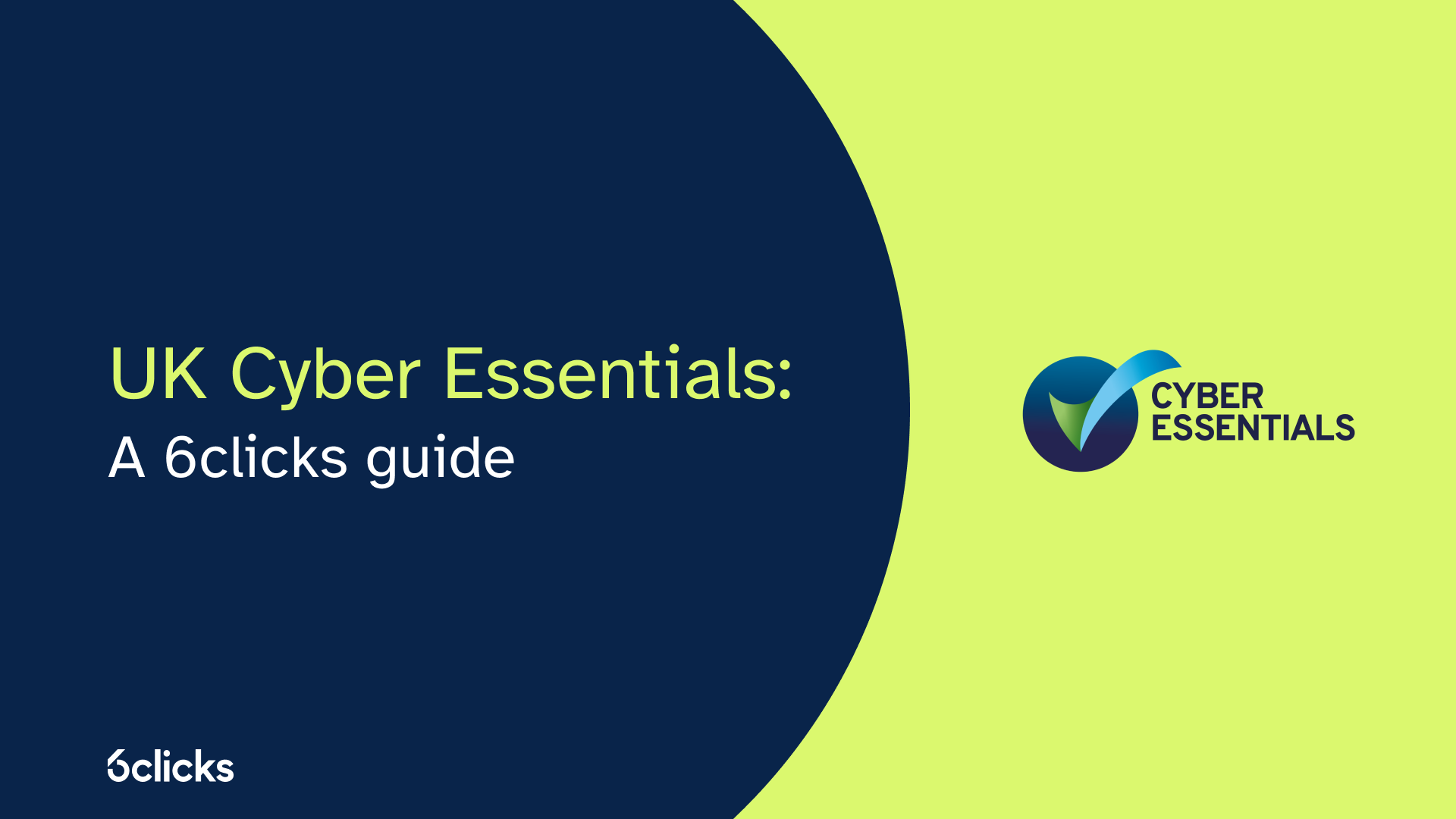
The UK Cyber Essentials scheme is a government-backed initiative designed to help organizations of all sizes strengthen their cybersecurity posture. It establishes a foundational set of security controls that businesses can implement to mitigate the risk of common cyber threats. Compliance with the UK Cyber Essentials also demonstrates an organization's commitment to cybersecurity which can help them obtain the trust of government entities.
Whether you aim to reassure clients, improve resilience, or prepare for government contracts, the UK Cyber Essentials scheme provides organizations with a framework to strengthen their defenses against advancing, modern cyberattacks.
What are Cyber Essentials' five key technical controls?
Cyber Essentials' five technical controls form a robust foundation for any organization's cybersecurity. Implementing these controls reduces an organization's vulnerability, serving as a crucial first line of defense in today's digital landscape.

Firewalls
Firewalls are barriers between your internal network and the broader Internet (or other untrusted networks). They monitor incoming and outgoing traffic and filter it based on predetermined security rules. Firewalls help achieve Cyber Essentials compliance through:
- Controlling network access: Firewalls are critical for defining what traffic is allowed into and out of your network. By blocking unauthorized access attempts, they help prevent hackers and malware from infiltrating your systems.
- Segmenting networks: Firewalls can divide your internal network into smaller segments, limiting an attack's potential spread if one part is compromised.
- Enforcing secure configuration: You must also properly configure your firewalls with rules that support your security policies. Cyber Essentials emphasizes ensuring firewall settings are secure and updated.
Secure configuration
Secure configuration refers to hardening devices and software in your IT environment to reduce vulnerabilities and minimize potential attack surfaces. That includes desktops, laptops, servers, mobile devices, network equipment, and applications.
Implementing secure configurations comes in different forms, including removing unnecessary software, establishing strong password policies, disabling unused ports and services, and enforcing operating system and application restrictions, allowing you to reduce your attack points.
Here are a few strategies to implement secure configuration:
- Establish standards and baselines. Leverage industry security standards (e.g., CIS Benchmarks) or frameworks from organizations like the UK's National Cyber Security Centre (NCSC).
- Use configuration management tools. These can help automate the application and maintenance of consistent, secure configurations across your devices.
- Track your secure configurations and regularly audit for compliance to ensure settings have stayed the same over time.
Access control
Access control defines the mechanisms and policies by which users (and systems) are granted or denied access to specific resources, data, or applications within an organization's IT environment. It ensures that only authorized individuals have the appropriate level of permissions to do their jobs.
Here are important considerations for Cyber Essentials to keep in mind:
- User roles and permissions should be reviewed frequently to align with job responsibilities.
- Access controls must apply to employees, contractors, vendors, and partners interacting with your systems.
- Remember that access controls also apply to the physical security of your IT infrastructure (e.g., server rooms and data centers).
Malware protection
Malware is a broad term for malicious software that harms computer systems and networks or steals data. It includes viruses, trojans, ransomware, spyware, and worms.
Here are the key elements of malware protection for Cyber Essentials:
- Antivirus and anti-malware software: Up-to-date solutions on all endpoints (desktops, laptops, servers) are essential. These solutions should detect and block known malware as well as potential threats.
- Regular scans: Scheduled scans and the ability to manually initiate them when needed are important.
- Automatic updates: Software must be updated with the latest malware definitions to protect against new threats.
- Web filtering: Blocking access to known malicious websites reduces the risk of exposure.
- User education: Employees need training on recognizing phishing emails, avoiding suspicious links, and being mindful of the files they download.
Patch management
Patch management involves identifying, acquiring, testing, and installing software updates (patches) across all devices and systems within an organization's IT network. These patches address known vulnerabilities and security flaws within operating systems, applications, and firmware.
The key elements of patch management for Cyber Essentials include inventory management, vulnerability tracking, and patch prioritization, testing, deployment, and documentation.
Importance of a Cyber Essentials certification
As cyberattacks become increasingly sophisticated, customers are more cautious than ever about the businesses they entrust with their data. Aside from protection against common threats and improved internal security practices, a Cyber Essentials certification can help you secure government contracts and set you apart from competitors who may not have the same level of commitment to data protection, therefore increasing your profitability.
Cyber Essentials also helps organizations align with various data protection regulations, such as the General Data Protection Regulation (GDPR), the Payment Card Industry Data Security Standard (PCI DSS), and other industry-specific regulations to facilitate cross-compliance.
Who needs a Cyber Essentials certification?
While not required for all businesses, Cyber Essentials is recommended as best practice for organizations of any size or across industries that aim to improve their cybersecurity posture and protect themselves from common cyber threats like malware and phishing.
However, Cyber Essentials is mandatory for organizations aiming to bid for government contracts that involve:
- Handling the personal data of UK citizens, like home addresses or bank details
- Handling advisors', ministers', or government employees' personal data, like expenses or payroll information
- Delivering IT products and services designed to transfer, process, or store data at an official level
Moreover, the Ministry of Defense mandates that organizations wishing to bid for MoD contracts be Cyber Essentials certified, and these businesses should also require their suppliers or vendors to be certified to mitigate risks within their supply chains.
What is the process for obtaining a Cyber Essentials certification?
Before diving into the certification process, let's differentiate Cyber Essentials and Cyber Essentials Plus.
Cyber Essentials is based on a self-assessment questionnaire demonstrating that you've implemented the five core technical controls. It is suitable for smaller businesses or those looking for a foundational level of cybersecurity certification and assurance.
On the other hand, Cyber Essentials Plus includes a self-assessment along with a more rigorous technical audit where an independent assessor verifies the implementation of the controls. Cyber Essentials Plus is the most suitable option for organizations with higher security needs, those handling sensitive data, or those facing stricter compliance requirements or client expectations.
To obtain a Cyber Essentials and Cyber Essentials Plus certification, follow these steps:
Prepare for the certification process
Organizations should ensure they have the systems and resources to meet the Cyber Essentials scheme's requirements. That often involves fortifying security measures, such as patching vulnerabilities, updating software programs, and implementing the appropriate access controls.
Complete the self-assessment questionnaire
Another crucial step is completing the self-assessment questionnaire, which covers the five key technical controls (firewalls, secure configuration, access control, malware protection, and patch management). Organizations must answer questions about their existing security controls and provide proof supporting their responses.
Conduct an external assessment
The next step is to undergo an external assessment. An independent certification body is responsible for reviewing the questionnaire and conducting a vulnerability scan to check an organization's existing system. Then, they will verify whether the organization has met the requirements and award the certification based on their assessment.
Implement the required recommendations
If the certification body finds any vulnerabilities in an organization's security measures, it will provide recommendations for improvement, which businesses must implement within a set timeframe to maintain their certification.
Prepare for the annual certification
Maintaining the Cyber Essentials certification requires annual renewal. Organizations must complete the self-assessment questionnaire and a new external assessment to ensure continuous compliance and improvement in their cybersecurity practices.
The Cyber Essentials certification process provides a clear and achievable roadmap for strengthening an organization's cybersecurity posture. By understanding the necessary steps, organizations can significantly enhance their defenses and demonstrate their commitment to data protection.
Key takeaways
The UK Cyber Essentials provides a robust framework for organizations to strengthen their cybersecurity defenses against common cyber threats. By implementing the five key technical controls — firewalls, secure configuration, access control, malware protection, and patch management — businesses can significantly reduce their vulnerability to prevalent attacks like malware, phishing, and unauthorized access attempts.
Achieving a Cyber Essentials certification is pivotal for demonstrating your organization's commitment to data protection and building trust with customers, partners, and stakeholders. It enhances an organization's security posture and positions them for better business opportunities, including eligibility for profitable government contracts that involve handling sensitive information.
To obtain a Cyber Essentials certification, organizations must go through self-assessment, external assessment, and necessary improvements. Remember that maintaining the certification requires annual renewal, ensuring continuous compliance and improvement in cybersecurity practices.
Take the next step with 6clicks
Secure your UK Cyber Essentials and Cyber Essentials Plus certification through our UK Cyber Essentials compliance solution. Download the UK Cyber Essentials requirements from the 6clicks Content Library and utilize our UK Cyber Essentials question set to conduct a comprehensive audit of your organization in compliance with the self-assessment and annual assessment requirements.
6clicks’ Audits and Assessments module allows you to perform question-based and requirement-based assessments and automate response assignment through custom workflows. The 6clicks Content Library offers ready-to-use assessment and reporting templates, control sets, and risk libraries to help you augment your cyber risk and security compliance processes.
Audit findings and recommendations can then be efficiently managed, monitored, and resolved within the Issues & Incident Management module using custom issue submission forms and powerful task-tracking features.
Hailey, 6clicks’ AI engine, can also help you map your internal policies and controls to the UK Cyber Essentials requirements at the click of a button, providing you with an in-depth understanding of your level of compliance and enabling you to proactively address compliance gaps.
Lastly, you can share your audit findings with assessors through the 6clicks Trust Portal and reassure customers and stakeholders with up-to-date information on your security posture.


